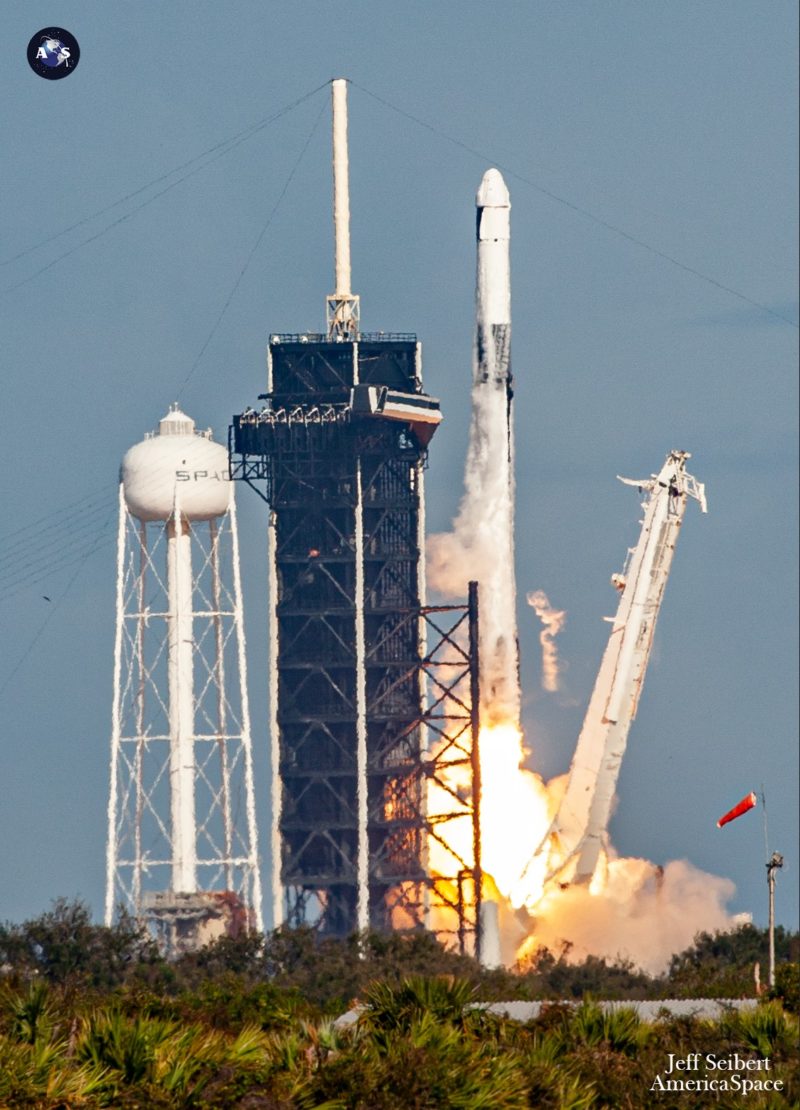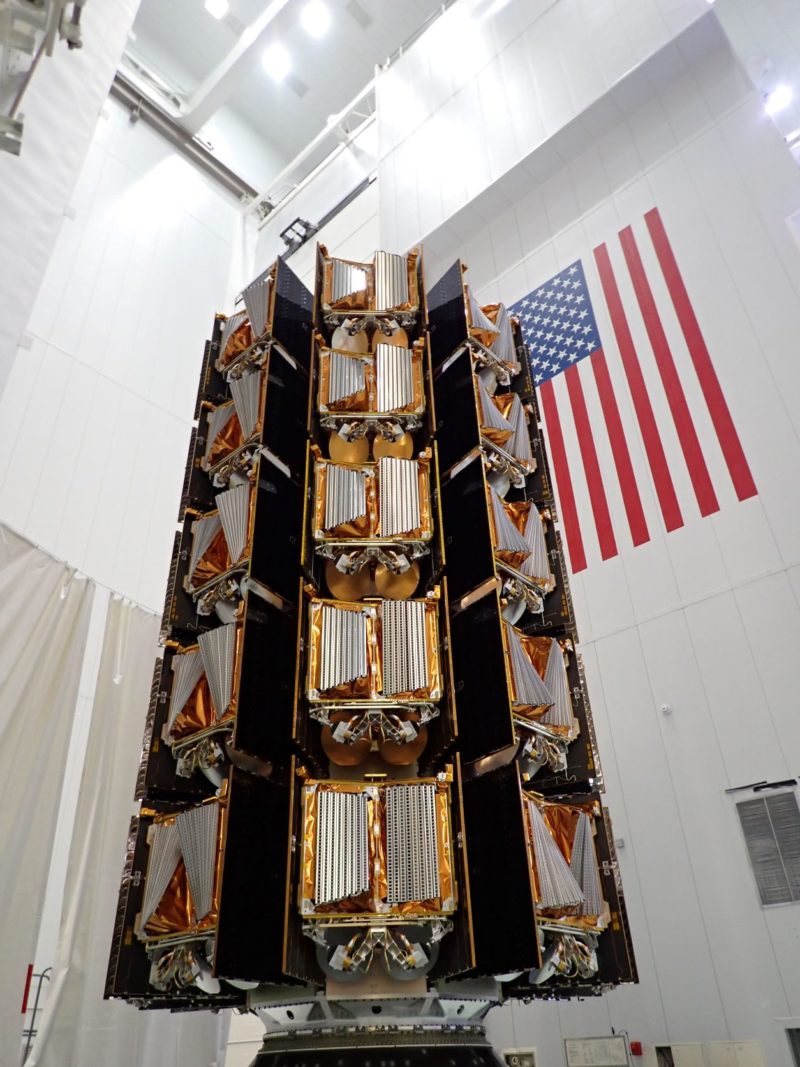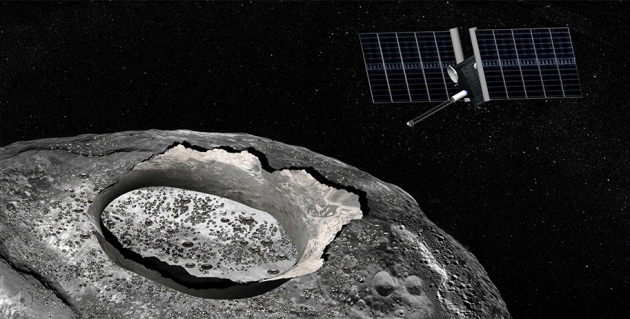
SpaceX aims to launch three missions from the East and West Coasts of the United States in the coming days, beginning with Sunday night’s scheduled liftoff of a seasoned Falcon 9 booster from storied Space Launch Complex (SLC)-40 at Cape Canaveral Space Force Station, Fla. The once-before-flown B1076 core—which entered service late last November to lift the CRS-26 Cargo Dragon on the first leg of its trek to the International Space Station (ISS)—is scheduled to rise from Earth at 11:55 p.m. EST Sunday, laden with 40 OneWeb broadband internet satellites, destined for insertion into near-polar orbit.
According to the 45th Weather Squadron at Patrick Space Force Base, conditions are expected to be around 90-percent-favorable for Sunday night’s opening launch attempt and will remain broadly the same for Monday night’s backup try, whose T-0 moves a few minutes earlier to 11:50 p.m. EST. B1076 will end her second mission by alighting on solid ground at Landing Zone (LZ)-1, downrange of SLC-40 at the Cape.
“High pressure extends over the Florida peninsula with clear skies and light winds throughout the day today,” noted the 45th in its L-1 update, issued early Saturday morning. “Tomorrow, onshore flow ahead of another approaching weak cold front will slowly increase moisture during the daytime hours, bringing a slight chance of low-topped showers, but by Sunday evening winds will shift southwesterly, diminishing chances of precipitation.

“Some lingering showers could remain off the coast, so the Cumulus Cloud Rule remains the only concern,” the forecast added. “By Monday morning, the front and associated upper trough will pass through the area and usher in dry air once again and very favorable conditions by the launch window.”
Tomorrow night’s scheduled launch will be SpaceX’s second of 2023, coming hard on the heels of last week’s Transporter-6 “rideshare” mission, which carried 114 discrete payloads spanning a smorgasbord of disciplines from technology demonstrations to amateur radio, Earth observations to communications and air-traffic management to Internet of Things (IoT), sponsored by no fewer than 17 sovereign nations. It will also mark the second back-to-back touchdown of a Falcon 9 core on solid ground in the second week of 2023 and the sixth booster to do so in less than one month.

Primary payload on tomorrow night’s launch are 40 high-speed, low-latency broadband microsatellites, flying on behalf of London, England-headquartered OneWeb. Each satellite reportedly weighs in the region of 275 pounds (125 kilograms) and is destined to reside at an orbital altitude of 750 miles (1,200 kilometers), inclined 86 degrees to the equator.
The first 13 OneWeb launches between February 2019 and February of last year totaled 428 satellites. This represented about 66 percent of OneWeb’s planned first generation of 648 satellites and was placed into orbit via Russia’s Soyuz booster out of the Guiana Space Center in Kourou, French Guiana, the Baikonur Cosmodrome in Kazakhstan and the Vostochny Cosmodrome in the Russian Far East.

But following President Vladimir Putin’s invasion of Ukraine last spring, and a resultant raft of economic sanctions imposed by Western governments upon Russia, OneWeb suspended six further launches out of Baikonur and began to source alternate launch providers.
Last March, the company contracted with SpaceX, then added New Space India Ltd., the commercial arm of the Indian Space Research Organisation (ISRO), to its launcher portfolio in April.

Thirty-six OneWebs duly rode the first of two planned Indian Geosynchronous Satellite Launch Vehicle (GSLV) III boosters from the Satish Dhawan Space Centre in Sriharikota, Andhra Pradesh, last October, raising the total number of satellites placed into orbit to 462. And just last month, a Falcon 9 lifted 40 more OneWebs to space in the first of three SpaceX launches to be completed by later this spring.
According to OneWeb, tomorrow’s second batch of 40 SpaceX-flown OneWebs—which will tip the scales at a little more than 13,000 pounds (5,900 kilograms)—will bring the first-generation constellation to 542 satellites, or more than 80-percent-complete. A definitive No Earlier Than (NET) date for the third Falcon 9 launch has not been announced, but is expected to occur within the year’s first quarter.

After tomorrow night’s 11:55 p.m. EST liftoff, B1076’s nine Merlin 1D+ engines will provide the muscle for the first 2.5 minutes of ascent, before the core separates and descends to land at LZ-1. The single Merlin 1D+ Vacuum engine of the second stage will then ignite for a customary six-minute “burn”, after which the stack will enter a period of “coasting”, scheduled to last around 45 minutes.
Beginning just under an hour after liftoff, the 40 satellites will commence deployment, departing the Falcon 9’s second stage in pairs, at intervals spaced from as little as 20 seconds to as long as ten minutes apart. The process is expected to be complete about one hour and 35 minutes after tomorrow’s launch.

But Sunday’s launch marks only the start of a rapid tempo of three launches in the next few days. Attention will shift sharply to Space Launch Complex (SLC)-4E at Vandenberg Space Force Base, Calif., where the B1063 core—which already has eight prior missions under her belt, including five from the West Coast in 2022 alone—is set to launch 2023’s inaugural batch of Starlink internet communications satellites during an “instantaneous” window opening at 8:15 p.m. PST (11:15 p.m. EST) Monday, 10 January.
In support of the mission, the Autonomous Spaceport Drone Ship (ASDS), “Of Course I Still Love You”, put to sea from Port of Long Beach earlier on Saturday, bound for a recovery location in the Pacific Ocean. However, with storms having battered the California coast and rainstorms anticipated on Monday, it remains to be seen if SpaceX with “thread the needle” and get this third mission of 2023 airborne on time.

The 51 Starlinks heading uphill on B1063 are destined for emplacement into orbit 350 miles high (570 kilometers), inclined 70 degrees to the equator, with deployment about 29 minutes after liftoff. Monday’s launch will bring to 3,715 the total number of these flat-packed low-orbiting internet communications satellites launched since May 2019.
Attention will then shift to historic Pad 39A at Florida’s Kennedy Space Center (KSC), where the first of up to five Falcon Heavy missions planned for this year is set to begin around 5:45 p.m. EST on Thursday, 12 January. If accomplished, 2023 will end with more Falcon Heavy launches in a single calendar year than it previously achieved in its first four years of operational life.

Of note, in October, a Heavy will loft NASA’s Psyche mission to visit the metal-rich Main Belt asteroid of the same name. Other payloads heading uphill in 2023 aboard these triple-barreled behemoths include four heavyweight geostationary communications satellites and the highly secretive USSF-52 and USSF-67 missions for the U.S. Space Force.
And it is USSF-67 which will take center-stage on Thursday’s launch. It is expected that the brand-new center core for this mission will be expended, whilst the two side-boosters—which previously flew on the Heavy’s most recent outing, last November—will return to synchronized touchdowns on Landing Zones (LZ)-1 and 2 at the Cape, promising to startle East Coast rocket-watchers with a pair of synchronized sonic booms.

Contracts worth $316 million to launch USSF-67 were awarded to SpaceX in August 2020. Its multi-faceted payload includes the second Boeing-built Continuous Broadcast Augmenting SATCOM (CBAS-2), targeting a spot in geostationary orbit to furnish enhanced military communications and the uninterrupted broadcasting of military data.
Thought to weigh in the region of 5,500 pounds (2,500 kilograms), a previous CBAS flew aboard the former Air Force Space Command’s AFSPC-11 mission, via a United Launch Alliance (ULA) Atlas V, in April 2018. Also aboard USSF-67 is LDPE-3A, a mouthful of an acronym denoting the Long Duration Propulsive ESPA, which carries a suite of experimental payloads affixed to an Evolved Expendable Launch Vehicle (EELV) Secondary Payload Adapter (ESPA) “ring”.





